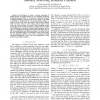501 search results - page 40 / 101 » Communication Lower Bounds Using Dual Polynomials |
CAV
2001
Springer
14 years 14 days ago
2001
Springer
We consider the randomized consensus protocol of Aspnes and Herlihy for achieving agreement among N asynchronous processes that communicate via read/write shared registers. The alg...
ICC
2009
IEEE
14 years 3 months ago
2009
IEEE
— In this paper, we derive a precise expression of spatial degrees of freedom (DOF) for two mutually interfering broadcast channels (IFBC) as a function of arbitrary numbers of t...
IPCO
1998
13 years 10 months ago
1998
We provide several non-approximability results for deterministic scheduling problems whose objective is to minimize the total job completion time. Unless P = NP, none of the probl...
JGO
2010
13 years 3 months ago
2010
The best known method to find exact or at least -approximate solutions to polynomial programming problems is the spatial Branch-and-Bound algorithm, which rests on computing lower...
ISAAC
2004
Springer
14 years 2 months ago
2004
Springer
We propose a model of computation where a Turing machine is given random access to an advice string. With random access, an advice string of exponential length becomes meaningful ...

